Through his two-year SOURCE fellowship, Jaggena will work with both Professor Aaron Mohammed and Professor Todorova to study mercury contamination in waterways.
Studying Mercury Contamination in Waterways: Charan Jaggena ’28
Fabrizio Sabba
Degrees:
Ph.D., Civil and Environmental Engineering – University of Notre Dame, 2017
M.Sc., Environmental and Industrial Biotechnology – Sapienza University of Rome, Italy, 2010
B.Sc., Biotechnology for Processes and Products Innovation – University of Bari, Italy, 2007.
Areas of Expertise:
- Sustainable biological wastewater treatment
- Resource and energy recovery from waste
- Microbial nitrogen and phosphorus cycling
- Biofilms and biofilm reactors
- Mathematical modeling of bioprocesses
Our group focuses on advancing sustainable biological wastewater treatment by integrating microbial ecology, process engineering, and systems modeling. We investigate microbial nitrogen and phosphorus cycling, with an emphasis on enhancing nutrient removal performance and stability. One area of interest is biofilms and biofilm reactors, which offer opportunities for treatment intensification and selective enrichment of functional microbial communities. We develop and apply mathematical models to connect microbial population dynamics with reactor performance, enabling predictive and data-informed decision-making. Our research also explores strategies for energy and resource recovery from waste streams, helping for the development of a circular and climate-resilient water infrastructure. By bridging fundamental microbial insights with applied engineering solutions, our group aims to design and optimize next-generation treatment systems that are efficient, robust, and environmentally responsible. Through close collaboration with utilities, industry, and academic partners, we seek to accelerate the translation of research into impactful solutions for water sustainability.
Honors and Awards:
AEESP Distinguished Service Award, 2024
40 under 40 Award – American Academy of Environmental Engineers and Scientists, 2022
Postdoc Professional Development Award, 2019
Best presentation at WWTmod Conference, Annecy (France), 2016
Selected Publications:
Downing, L., Farmer, M., Bhattarai, B., Penn, M., Kozak, J., Grabowy, J., Sabba, F. (2025), Making waves: Rethinking our mission for N2O emissions at WRRFs, Water Research X, 28:100320 | DOI: 10.1016/j.wroa.2025.100320
Sabba, F., Kassar, C., Zeng, T., Mallick, S., Downing, L., McNamara, P. (2025), PFAS in landfill leachate: Practical considerations for treatment and characterization, Journal of Hazardous Material, 481:136685| 10.1016/j.jhazmat.2024.136685
Sabba, F., Farmer, M., Dunlap, P., Qin, C., Barnard, J., Wells, G., Downing, L. (2025), Unlocking the potential of sidestream EBPR: exploring the coexistence of PAO, GAO and DGAO for effective phosphorus and nitrogen removal, Water Science & Technology, 91:5, 469-481 | DOI: 10.2166/wst.2025.038
Cecconi, F., Pifer, L., Sabba, F., Downing, L. (2024), Improving carbon management through maximizing hydrolysis and fermentation at water resource recovery facilities, accepted in Frontiers in Environmental Engineering, 3:1378621 | DOI: 10.3389/fenve.2024.1378621
Sabba, F., Redmond, E., Ruff, C., Ramirez, M., Campbell, P., Young, M., Downing, L. (2024), Exploring community and kinetic shifts in nitrifying microbial communities in low dissolved oxygen activated sludge facilities for energy-efficient biological nitrogen removal, ES&T Water, DOI: 10.1021/acsestwater.3c00715
Farmer, M., Sabba, F., Jia, Z., Dunlap, P., Barnard, J., Qin, D., Straka, L., Kozak, J. A., Downing L., Wells, G. (2023), Confronting assumptions of phosphorus-accumulating organisms and glycogen-accumulating organisms: peaceful coexistence in a carbon-limited sidestream EBPR demonstration, ES&T Water, 3:8, 2384–2394 | DOI: 10.1021/acsestwater.3c00083
Sabba, F., Farmer, M., Jia, Z., Di Capua, F., Dunlap, P., Barnard, J., Dongqi Qin, C., Kozak, J. A., Wells, G., Downing, L. (2023), Impact of operational strategies on a sidestream enhanced biological phosphorus removal (S2EBPR) reactor in a carbon limited wastewater plant, Science of The Total Environment, 857:159280 | DOI: 10.1016/j.scitotenv.2022.159280
Sabba, F., Farmer, M., Barnard, J., Dunlap, P., Marroquin, S., Giefer, R., Budsberg, D., Downing, L. (2022), Enhancing resource recovery via cranberry syrup waste at the Wisconsin Rapids WRRF: an experimental and modeling study, Journal of Environmental Management, 323:116190 | DOI: 10.1016/j.jenvman.2022.116190
Flood Forecasting
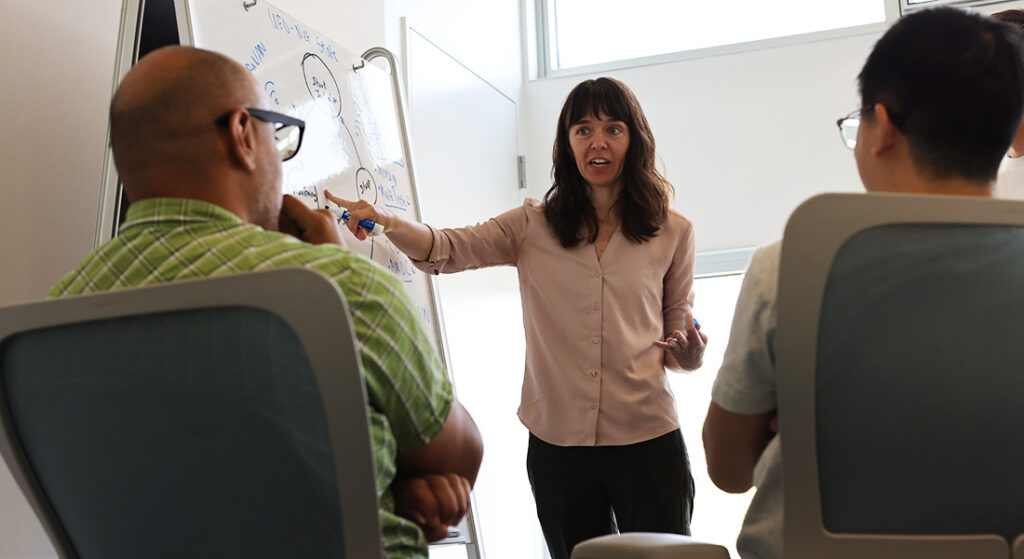
After Hurricane Katrina ravaged the southern coastline of the United States in 2005, Elizabeth Carter found herself on the Gulf Coast following the tropical storm’s aftermath. Witnessing the devastating impact of the hurricane on infrastructure and communities, she decided to place her undergraduate education on hold and join the efforts to rebuild – an experience that would be the catalyst for her future research.
“It was pivotal a time in U.S. history. It exposed a lot of the ways that structurally our publicly funded infrastructure is shunting risk down socioeconomic gradients,” Carter says. “As a young person figuring out what I wanted to do in the world, I didn’t think I could walk away from something like that and retain my humanity.”
Ignited with a passion for the environment, Carter returned to school and received her bachelor’s degree in soil science, a master’s in environmental information science and a Ph.D. in environmental engineering with a concentration in water resources. Now working as an assistant professor in civil and environmental engineering with a joint appointment as an assistant professor in earth and environmental sciences in the College of Arts and Sciences, Carter is a computational hydrologist who studies the movement of water from space. Using data from satellites, these observations of water movement allow her to develop ways to respond to natural disasters and manage water resources.
She and her research team at Syracuse University have received a water resource grant from the United States Geological Survey (USGS) to develop a sensor network that measures flooding. This sensor network will help predict different types of flooding caused by natural disasters, particularly flooding in areas where people live, which is referred to as urban flooding. This project is known as the Urban Flood Observing Network.
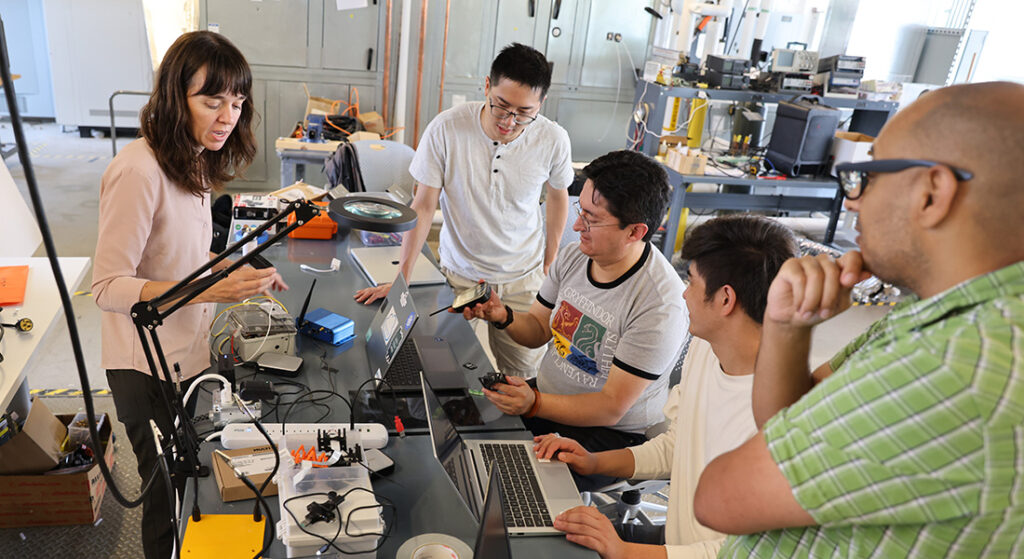
“We’re hoping to build a sensor network for better urban flood response and labels for satellite images so they can map urban flooding everywhere,” says Carter.
Fatemeh Rezaei G‘25 (environmental engineering), Huantao Ren G’21, Ph.D. ‘27 (computer science), Manu Shergill ‘24 (computer science) Nhy’ere Scanes, Ike Unobhaga, Kaitlyn Gilmore and Sharif Jafari are students from Syracuse University and Onondaga Community College (OCC) who have helped with the development of the Urban Flood Observing Network. Collaborators on the project include electrical engineering and computer science professor Senem Velipasalar and associate professor at the School of Information Studies, Carlos Caicedo.
“It’s been a great way to engage a lot of different students from different backgrounds and stages in their careers in hardware design, 3d printing, algorithm design, and photogrammetry,” says Carter.

Shergill is the primary developer leading the project and has been working on the sensor network since 2021. During a summer internship in his freshman year at OCC, he assembled the initial version of the water sensor camera. He’s also been working on adding higher-quality sensors, wireless communications, machine vision, and other features to the water sensor camera, hoping to install it on the roof of Syracuse’s Center of Excellence for testing.
“The next thing I’m tackling is a remote start function, so we can trigger continuous data collection when a storm is moving into the area the sensor is monitoring,” says Shergill.
Carter has hopes the USGS will install these sensor networks in different locations where quick responses to flood events are needed which can help manage future flood events.
“It’s been great to collaborate with different students on this project and make an impact on tackling natural disasters that are a result of climate change,” Carter says.

Interdisciplinary Engineering Group Designs Smart Water Box for U.S. Environmental Protection Agency’s P3 Program
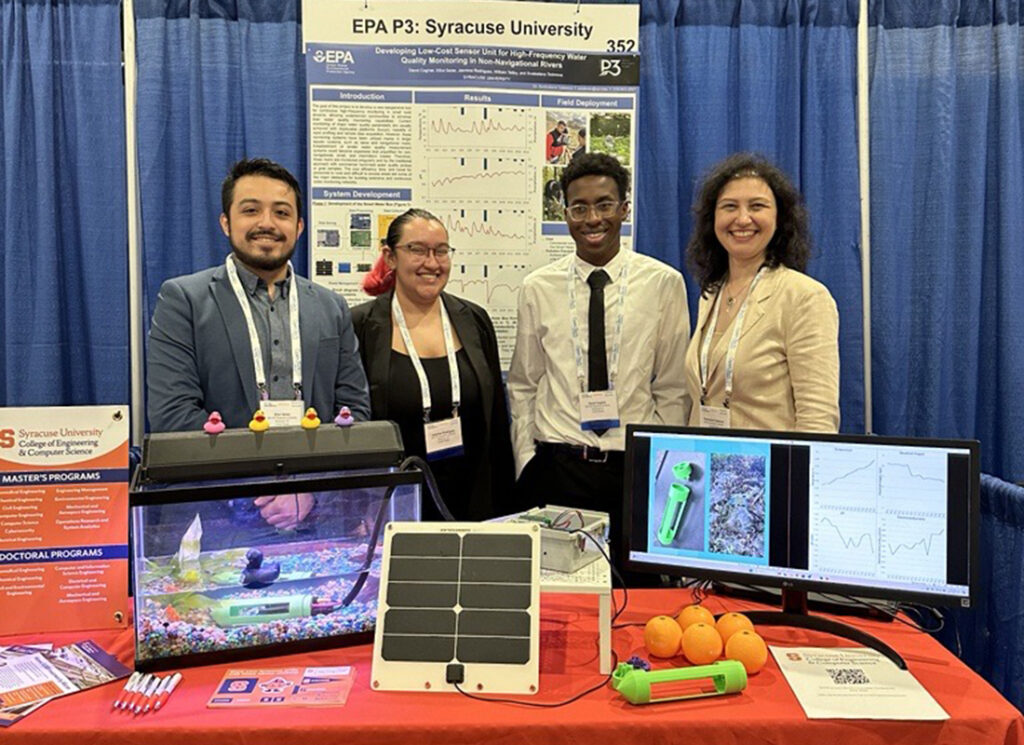
Civil and environmental engineering professor Svetoslava Todorova, retired electrical engineering and computer science professor William Tetley, engineering students David Coghiel ‘24 (civil engineering), Elliot Salas ‘24 (electrical engineering) and Jasmine Rodriguez ‘25 (mechanical engineering) participated in the TechConnect World Innovation Conference and Expo in Washington, DC from June 17-19. The group was a recipient of the U.S. Environmental Protection Agency’s (USEPA) People, Prosperity and the Planet (P3) competitive program grant.
The EPA’s P3 program is a competition where undergraduate/graduate student teams design sustainable solutions to real-world environmental challenges. Todorova, Tetley, Coghiel, Salas and Rodriguez showcased their Smart Water Box, a low-cost sensor unit designed to monitor water quality in small rivers, in a 90-second sales pitch and answered questions in a booth where they displayed their sensor unit.
“The TechConnect World Innovation Expo was a great opportunity that I utilized to network with other student researchers, government agencies, and private companies,” says Rodriguez. “As one of the few student attendees, it was easy to stand out and make better connections with the professionals I interacted with. The P3 National Student Design Competition also gave me valuable insight into what other universities are researching and what issues are at the forefront of people’s concerns when it comes to our environment.”
“Our project stood out as a cost-effective, low-maintenance, solar-powered alternative to traditional water quality monitoring systems. I assisted with the development of the unit and fieldwork to ensure its continuous operation,” says Coghiel. “I was able to connect with different universities and companies to share experiences, knowledge, and accomplishments. Furthermore, introducing our project in an elevator pitch and a booth in the conference hall gave us valuable presentation experience that is bound to help us in our careers.”
P3 has a two-phase program where teams receive $25,000 for a one-year award. The expo concluded phase 1 of the EPA P3 award cycle and the group will compete for the second round of funding in phase 2 during the fall.
“The experience of presenting our project to other schools and EPA representatives was incredibly rewarding,” says Salas. “I was also thrilled to support my team and celebrate their achievements, like David’s impressive elevator pitch and Jasmine’s unique 3D prints, which are integral to our project. While I served a significant role in this project, I must acknowledge the collective effort of our group and the guidance of our mentors, Svetla and William. The time spent in DC was enjoyable and inspiring, and I eagerly anticipate the future improvements our group will make to the water quality monitoring box.”
“Although we discuss the need of using a multifaceted approach in solving contemporary issues, at college level students are often taught in silos. This design project stimulated interdisciplinary collaboration and creativity by bringing together students from three different engineering departments,” says Todorova. “I am extremely proud of their motivation, team spirit, and drive for success. The team stood out with their 90-seconds sales pitch. Everyone came to congratulate us. We are thankful to Linda Hartsock, Strategic Advisor at SU Libraries, for her invaluable guidance and tips in developing a strong sales pitch.”
Syracuse University Joins Team in $650K National Science Foundation Award to Accelerate Drinking Water Solutions for Small Communities

With funds sub-awarded through the U.S. National Science Foundation’s (NSF) Convergence Accelerator program, Syracuse University’s Center for Sustainable Community Solutions (CSCS) will help develop more accessible pathways for small communities to develop and maintain safe drinking water infrastructure. This collaborative project will focus on communities in Puerto Rico, with the ultimate goal being to use this case study as a framework that can be replicated in other U.S. locations and beyond. The project officially kicked off in February 2024.
Access to clean drinking water is a right for all that is threatened by the looming climate crisis. In 2022, 2.2 billion people lacked safely managed drinking water; and 2 billion people lacked a basic hand washing facility, according to the National Institutes of Health.
Many of those without access are communities of less than 10,000 people who face their own unique obstacles. In Puerto Rico, challenges for these small communities include limited economic resources and severe natural disaster risk, which is amplified by climate change. Unless viable and proactive solutions are developed, this lack of access will prevail.
This $650,000 research project, named VersaWater by its team, is funded by the NSF Convergence Accelerator Program and led by Cornell University in partnership with CSCS; Interamerican University of Puerto Rico’s Center for Environmental Education, Conservation and Research; and AguaClara Reach.
Through the Convergence Accelerator Program, the water research team will use a multidisciplinary, collaborative approach to accelerate the science and community engagement practices around Puerto Rico’s safe drinking water technology using three convergent focus areas: governance and financing, community education and workforce training, and resilient water system technologies.
“The Center for Sustainable Community Solutions (CSCS), which operates the Environmental Finance Center (EFC), has been a leader in environmental finance for over 30 years,” shared CSCS Director and the water project’s Co-Principal Investigator Melissa Young. “Ensuring that funding is not only available for investments like this but that it is also accessible is crucial to making everlasting change for the health and welfare of small communities.”
She continued, “We’re proud to be a part of the esteemed NSF Convergence Accelerator Program, which importantly prioritizes community-focused research and social impact.”
CSCS aims to identify how small communities can better access federal funding made available through the Bipartisan Infrastructure Law (BIL) — a law that authorized billions of dollars for federal investment, including significant financial support for water infrastructure in small communities — and the barriers they experience in doing so. CSCS leverages over three decades of community-based work in EPA Region 2 (which includes New York, New Jersey, Puerto Rico, the U.S. Virgin Islands, and eight Native Nations.)
Cornell Engineering is leading VersaWater (formerly called WaterSAVerS), bolstered by its ties to the non-profit AguaClara Reach, who have together been developing open-source sustainable water treatment technologies specifically for small and very small communities in the Global South over the past 20 years, according to Ruth Richardson, the water project’s Principal Investigator representing Cornell.
“The AguaClara technology aims to create gravity-powered water treatment plants specifically for small and very small communities. Innovations in automated dosing, water movement, and hydraulics create treatment plants that ease operation and maintenance demands since labor is a major cost for [these communities],” Richardson said.
What’s ahead
CSCS and team are currently in Phase 1 of the NSF Convergence Accelerator Program. Over the course of nine months, the water team will develop their initial idea into a proof of concept, identify new team members and partners, and participate in the NSF Convergence Accelerator’s Phase 1 innovation curriculum, which provides fundamentals in human-centered design; team science; use-inspired research; early-stage prototyping; and communications, storytelling, and pitching.
At the end of Phase 1, the water team will participate in a competitive formal NSF pitch and proposal process, which is used in selecting teams for Phase 2. Teams selected for Phase 2 will continue accelerating their solutions toward impact. By the end of the Convergence Research phases, solutions are expected to impact societal needs at scale and be sustainable beyond NSF support.
The Center for Sustainable Community Solutions (CSCS) at Syracuse University
CSCS is a nonprofit organization working at the intersection of sustainability communications, policy, and science to foster economic well-being, environmental stewardship, and social equity by engaging community members at all levels to provide the coordination and knowledge needed to make informed decisions that
support sustainability, resiliency, and climate adaptation. The Syracuse University Environmental Finance Center (EFC), operated by CSCS, is a pillar in this mission that facilitates the development of sustainable and resilient communities throughout US EPA Region 2 (New Jersey, New York, Puerto Rico, the US Virgin Islands, and eight Native Nations) and nationally.
U.S. National Science Foundation
The U.S. National Science Foundation (NSF) is an independent federal agency that promotes the progress of science by investing in research to expand knowledge in science, engineering, and education across all 50 states and territories. NSF supports nearly 2,000 colleges, universities, and other institutions through competitive grants aimed at advancing science with broad impacts across the nation and its people. Learn more at nsf.gov.
About the NSF Convergence Accelerator
Launched in 2019, the NSF Convergence Accelerator—a TIP program—builds upon NSF’s investment in basic research and discovery to accelerate solutions toward societal and economic impact. The program’s multidisciplinary teams use convergence research fundamentals and innovation processes to stimulate innovative idea sharing and development of sustainable solutions. For more information about the program, visit new.nsf.gov/funding/initiatives/convergence-accelerator.
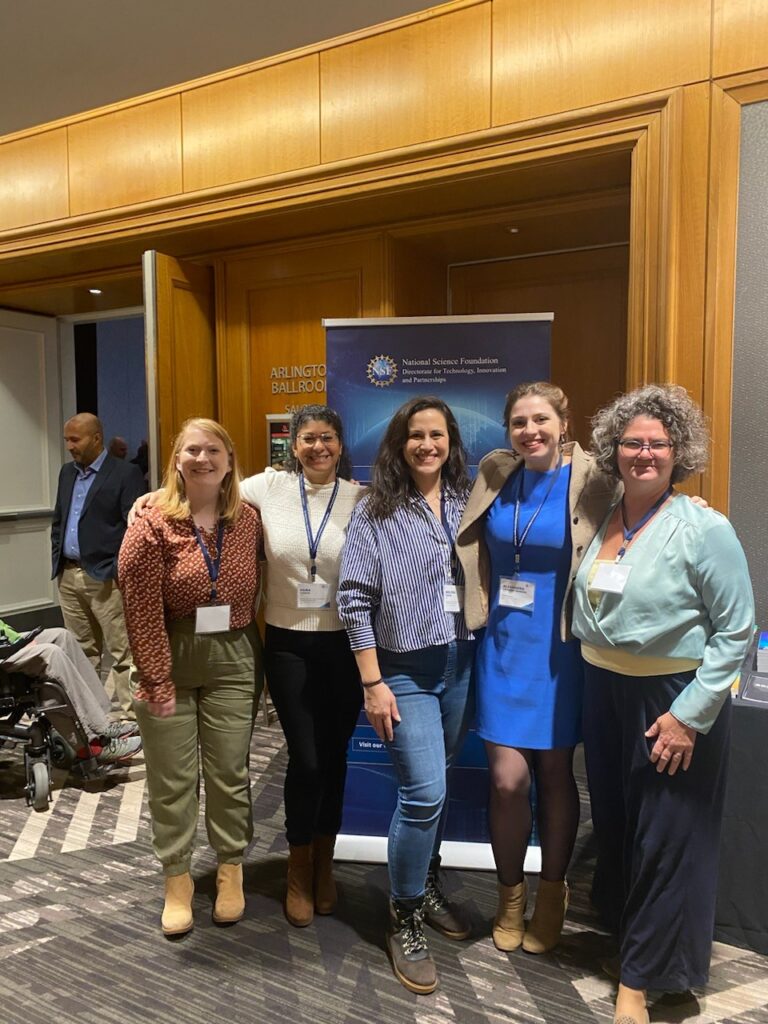
Civil and Environmental Engineering Research Group Wins 2024 Best Case Study Award from Environmental and Water Resources Institute
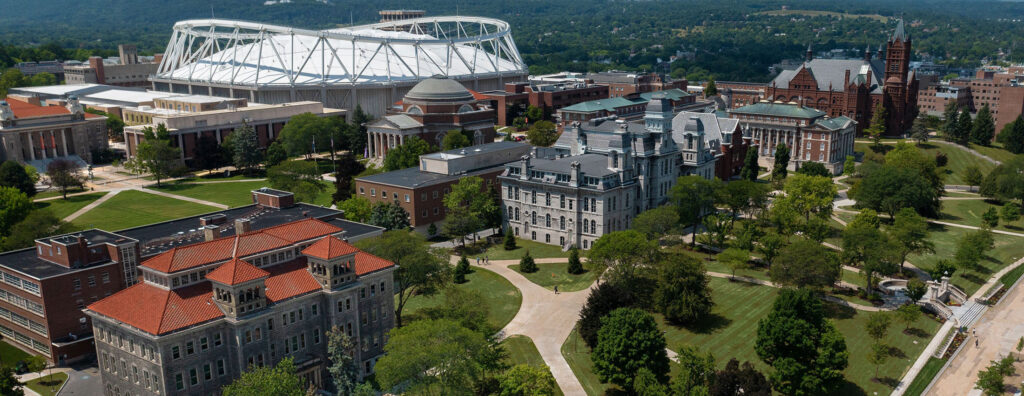
A civil and environmental engineering research group has won the 2024 Best Case Study Award in the Journal of Sustainable Water in the Built Environment. The paper was written by graduate student Lucie Worthen G’19 along with Assistant Professors Christa Kelleher from the College of Arts and Sciences and Cliff Davidson from the College of Engineering and Computer Science (ECS). The award is nominated and selected by the Environmental and Water Resources Institute (EWRI) editorial board.
The research group was awarded for their work on “A Diagnostic Analysis of Low-Impact Development Simulations with Stormwater Management Model (SWMM).” The paper compares the results of the SWMM of the U.S. Environmental Protection Agency with measurements of stormwater runoff from the green roof of the Nick Pirro Convention Center owned by Onondaga County.
Worthen, Kelleher, and Davidson will be recognized at the 2024 American Society of Civil Engineers (ASCE) Convention during the awards and lectures presentation.
Humanitarian Work in Water Systems
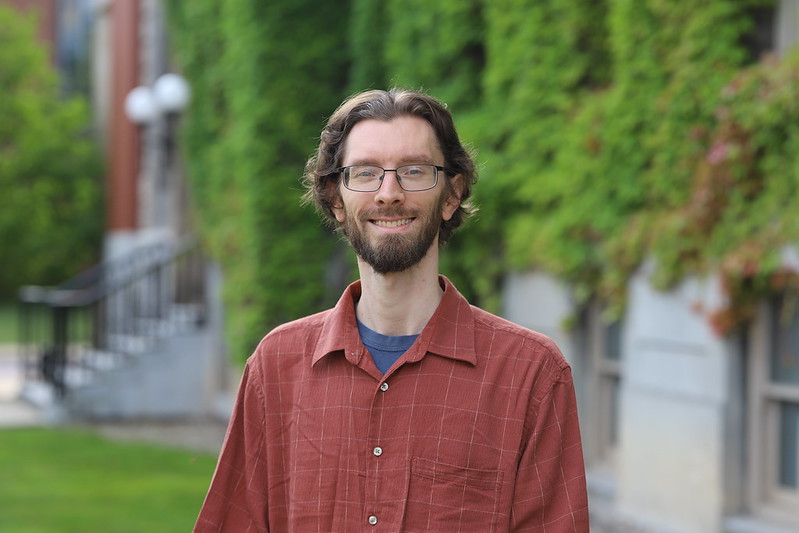
From the drylands of Kenya to the rainforests of Suriname, civil and environmental engineering professor John Trimmer has dedicated his career to making a difference. After a service-learning trip to Nicaragua, where he helped with construction projects, Trimmer was inspired to pursue humanitarian engineering and improve the well-being of others. With a core research focus on water systems, sanitation, and resource recovery, he strives to promote sustainable living.
As an undergraduate at Bucknell University, Trimmer was able to work with a few non-governmental organizations (NGOs). In addition to his trip to Nicaragua, he collaborated with a Peace Corps volunteer in Suriname, South America, stationed in a remote village and working on a rainwater collection system. After graduation, Trimmer continued working with the Peace Corps and spent three years in Uganda working with an NGO that specialized in constructing water tanks, latrines, classrooms, and other structures.
After completing his Ph.D., which included working in Uganda on innovative approaches to sanitation systems, Trimmer joined the Aquaya Institute on their mission to improve global health through safe water and sanitation access. His work at the Aquaya Institute largely focused on research and he found himself based in Nairobi, Kenya, interacting with pastoral communities in dry regions of the country.

“Though the communities were nomadic, it seemed like they were also looking to settle, and they were open to permanent infrastructure,” Trimmer says. “It was very qualitative. We focused primarily on asking questions regarding their current water systems and what they do for sanitation. We also did interviews and discussion groups to understand what these communities wanted and needed.”
While working with the Aquaya Institute, Trimmer also researched the effectiveness of a program that aimed to provide more durable infrastructure to vulnerable households in northern Ghana. Since unstable soil is an issue that impacts certain areas, they wanted to ensure the structures they built would last.
“If you dig a traditional pit latrine, it may collapse because the soil is unstable. Since the locals in the area didn’t have the means for a more durable structure, we were looking at different ways those systems could be supported financially,” Trimmer explained. “UNICEF funded the project so durable structures could be installed.”
As Trimmer has traveled to different countries, he’s loved working with young researchers and found it rewarding to help them develop their skills and witness their growth. This passion for mentoring younger researchers would translate to his position as a Syracuse University professor, giving him a chance to continue guiding and supporting students.
While teaching courses at the University, Trimmer plans to collaborate with NGOs he’s previously worked with on upcoming projects. He hopes to collaborate with colleagues to develop a platform that models sanitation systems to implement them as a teaching and research tool in the classroom. This will enable him to share the knowledge he’s gained from his humanitarian work and educate future researchers to do the same.
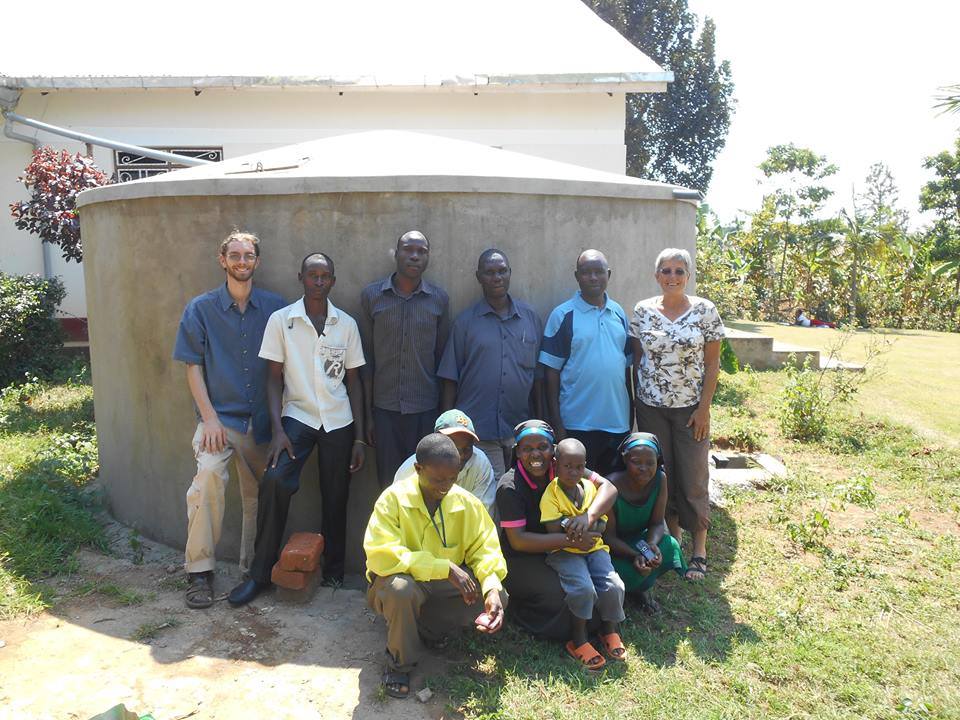
Reducing Plastic Pollution
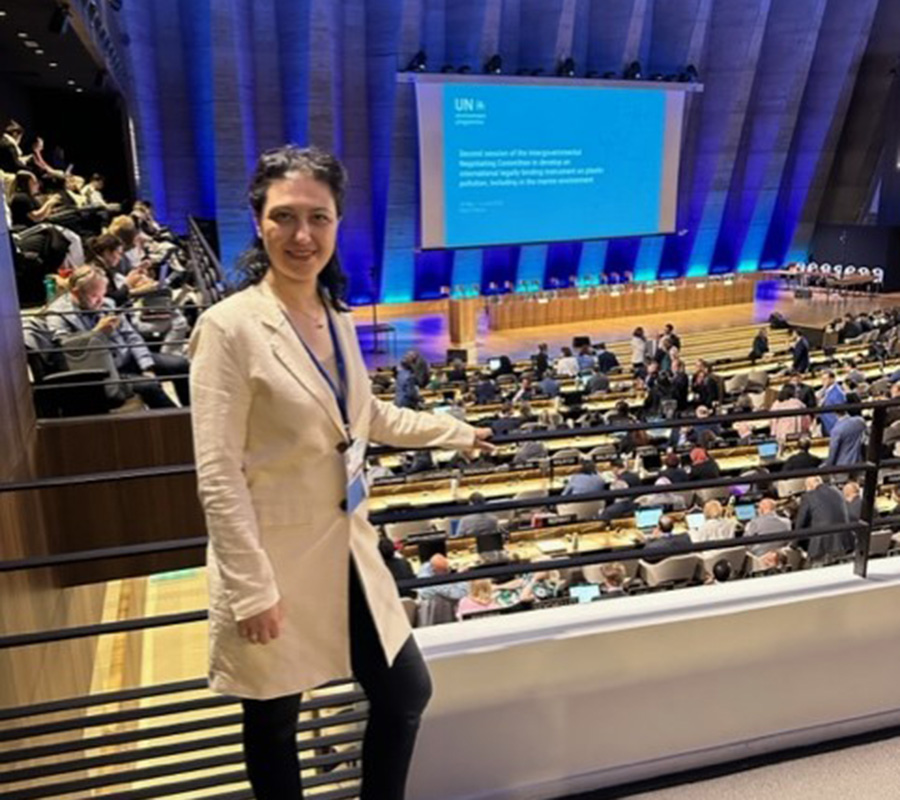
Civil and Environmental Engineering Professor Svetoslava Todorova attended the second session of the United Nations (UN) Intergovernmental Negotiations Committee on Plastics during the summer of 2023 in Paris, France.
Todorova joined representatives from UN member states, regional economic integration organizations, UN agencies and intergovernmental agencies in an attempt to develop an international legally binding instrument on plastic pollution, including in the marine environment. Unfortunately, the committee was unable to come to an agreement on a draft at the second session.
The next meeting of the committee will be held in November 2023 in Nairobi, Kenya. The committee has the goal of delivering a final agreement by the end of 2024.
“Overconsumption of plastics in a throw-away society generates a lot of waste. Much of it is not easily degradable and can persist in the environment. Single-use plastics visibly accumulate on the streets and in our waterways. I had hoped that the high visibility of problems connected to plastics pollution would make intergovernmental negotiations easier,” says Todorova. “Unfortunately, during the second session of the Intergovernmental Negotiations Committee, the delegates were locked in extensive discussions on basic principles and missed engaging in more substantive topics. This shows how difficult these negotiations will be and how challenging it will be to overcome divergent interests and opposition to progress in reducing plastics waste.”
Civil and Environmental Engineering Professor Charles Driscoll Selected for the 2023 Clarke Prize in Water Science

Civil and Environmental Engineering Professor Charles Driscoll has been selected to receive the 2023 Athalie Richardson Irvine Clarke Prize for Outstanding Achievement in Water Science and Technology from the National Water Research Institute. Driscoll is the University and Distinguished Professor of Environmental Systems Engineering in College of Engineering and Computer Science.
The Clarke Prize is considered one of the most prestigious awards pertaining to water science. It is awarded to thought leaders in water research, science, technology, or policy in the United States. Past honorees have included some of the most significant figures in civil and environmental engineering; the water, biological, physical, chemical, health, and political sciences; and public planning and policy.
Driscoll’s research largely involves characterization and quantifying the impacts of air pollution, such as acid rain and mercury, changing climate, and land and water disturbances on the structure and function of ecosystems, and pathways of ecosystem recovery. Much of his work has focused on forests and associated aquatic resources, including long-term studies at the Hubbard Brook Experimental Forest, NH and the Huntington Forest in the Adirondacks, NY. Recent work has included strategies for the decarbonization of sectors and achieving net zero greenhouse gas emissions.
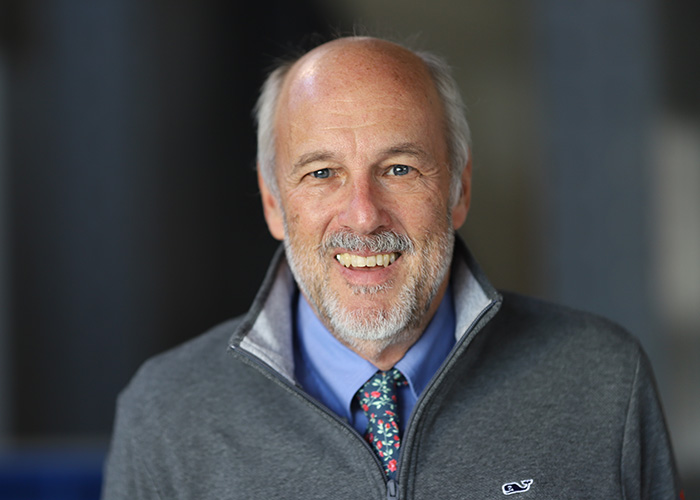
Over the past 40 years, Driscoll has advanced new analytical techniques, established and maintained long-term measurements and experiments, and developed a series of research and predictive models that simulate transformations of major chemical elements in forest vegetation, soil and surface waters in response to air pollution, climate and land disturbance. Beyond theory, he is interested in testing ‘in situ’ strategies to reverse the damaging effects of acid rain and mercury contamination, eutrophication, urbanization, and climate change. Driscoll has testified at US Congressional and state legislative committee hearings, and provided briefings to government agencies, industry and stakeholder groups on environmental issues. He has served on local, national and international committees pertaining to environmental management and policy.
Driscoll will receive the award and give a lecture in Irvine, California, on October 21, 2023. For information about attending the event, fill out the form on the Clarke Prize page.
Aaron Mohammed
Areas of Expertise:
Cold regions hydrology and hydrogeology
Permafrost thaw
Numerical modeling of hydrological processes
Coastal hydrogeology
Aaron Mohammed is an Assistant Professor in the Departments of Earth and Environmental Sciences and Civil and Environmental Engineering. His research focuses on the hydrology and hydrogeology of environments undergoing rapid changes due to climate warming and increased development. He is interested in the movement of water, energy, and chemicals through landscapes, and their interacting effects on hydrologic processes such as permafrost thaw, groundwater recharge, seawater intrusion, and contaminant transport. His research aims to improve our understanding of, and ability to predict, hydrological processes in a changing climate, and develop management strategies to enhance the resiliency of water and ecosystem resources.
Selected Publications:
Mohammed, A.A., Kurylyk, B.L., Cey, E.E., & Hayashi, M. (2018). Snowmelt infiltration and macropore flow in frozen soils: Overview, knowledge gaps, and a conceptual framework. Vadose Zone Journal, 17(1), 1-15.
Mohammed, A.A., Pavlovskii, I., Cey, E.E., & Hayashi, M. (2019). Effects of preferential flow on snowmelt partitioning and groundwater recharge in frozen soils. Hydrology and Earth System Sciences, 23(12), 5017-5031.
Mohammed, A.A., Bense, V.F., Kurylyk, B.L., Jamieson, R.C., Johnston, L.H., & Jackson, A.J. (2021). Modeling reactive solute transport in permafrost‐affected groundwater systems. Water Resources Research, 57(7), e2020WR028771.
Guimond, J.A., Mohammed, AA., Walvoord, M.A., Bense, V.F., & Kurylyk, B.L. (2021). Saltwater intrusion intensifies coastal permafrost thaw. Geophysical Research Letters, 48(19), e2021GL094776.
KarisAllen, J.J., Mohammed, A.A., Tamborski, J.J., Jamieson, R.C., Danielescu, S., & Kurylyk, B.L. (2022). Present and future thermal regimes of intertidal groundwater springs in a threatened coastal ecosystem. Hydrology and Earth System Sciences, 26(18), 4721-4740.
Mohammed, A. A., Guimond, J. A., Bense, V. F., Jamieson, R. C., McKenzie, J. M., & Kurylyk, B. L. (2022). Mobilization of subsurface carbon pools driven by permafrost thaw and reactivation of groundwater flow: a virtual experiment. Environmental Research Letters, 17(12), 124036.
Teng Zeng
Degrees:
- Ph.D. Civil Engineering, University of Minnesota, 2012.
- M.S. Environmental Science and Engineering, Singapore Stanford Partnership, 2007.
- B.S. Environmental Science, Tongji University, 2006.
Areas of Expertise:
- Occurrence and fate of organic micropollutants
- Environmental photochemistry of organic matter
- Formation and control of water treatment byproducts
- Wastewater surveillance for substance use assessment
Our group combines collaborative field sampling, organic trace analysis, and data analytics tools to study chemical processes in natural and engineered aquatic systems. Our research primarily focuses on the occurrence and fate of organic micropollutants in surface waters and groundwater, the impacts of harmful algal blooms and lake browning on organic matter photochemistry, and the formation and control of byproducts during water treatment and reuse. Our team also develops analytical methods based on high-resolution mass spectrometry to support substance use assessment through wastewater surveillance in New York.
Honors:
- Expanding Chemistry in SETAC Award, Society of Environmental Toxicology & Chemistry (2023)
- NSF CAREER Award, National Science Foundation (2022)
- Mentor of the Year, Center for Fellowship & Scholarship Advising, Syracuse University (2022)
- Meredith Teaching Recognition Award, Syracuse University (2020)
- North America New Chemist Travel Award, Society of Environmental Toxicology & Chemistry (2017)
- Ralph E. Powe Junior Faculty Enhancement Award, Oak Ridge Associated Universities (2017)
- ExCEEd Teaching Fellowship, American Society of Civil Engineers (2016)
Selected Publications:
- Vogel, E. J.; Neyra, M.; Larsen, D. A.; Zeng, T., Target and nontarget screening to support capacity scaling for substance use assessment through a statewide wastewater surveillance network in New York. Environmental Science & Technology 2024, 58 (19), 8518-8530.
- Wasswa, J.; Perkins, M.; Matthews, D. A.; Zeng, T., Characterizing the impact of cyanobacterial blooms on the photoreactivity of surface waters from New York lakes: A combined statewide survey and laboratory investigation. Environmental Science & Technology 2024, 58 (18), 8020-8031.
- Pu, C.; Zeng, T., Comparative evaluation of chemical and photolytic denitrosation methods for chemiluminescence detection of total N-nitrosamines in wastewater samples. Environmental Science & Technology 2023, 57 (19), 7526-7536.
- Wang, S.; Basijokaite, R.; Murphy, B. L.; Kelleher, C. A.; Zeng, T., Combining passive sampling with suspect and nontarget screening to characterize organic micropollutants in streams draining mixed-use watersheds. Environmental Science & Technology 2022, 56 (23), 16726-16736.
- Wang, S.; Wasswa, J.; Feldman, A. C.; Kabenge, I.; Kiggundu, N.; Zeng, T., Suspect screening to support source identification and risk assessment of organic micropollutants in the aquatic environment of a Sub-Saharan African urban center. Water Research 2022, 220, 118706.
Svetoslava Todorova
Degrees:
- PhD, Civil Engineering, Syracuse University
- MPA, Environmental Policy and Administration, Syracuse University
- MS, Environmental Engineering, Syracuse University
- BS/MS, Civil Engineering, University of Architecture, Civil Engineering and Geodesy, Bulgaria
Lab/ Center/ Institute affiliation:
- Center of Excellence in Environmental and Energy Systems (SyracuseCoE)
- Program for the Advancement of Research on Conflict Resolution (PARCC)
Areas of Expertise:
- Transport, cycling, and bioaccumulation of metals in aquatic environments
- Sustainable engineering practices in built and natural environments
- Urban stormwater management
- Smart sensing for monitoring water and air quality
- Science for policy formation and effective implementation
One aspect of my research focuses on using field and analytical approaches to study the fate and transport of mercury in aquatic ecosystems and develop technologies to mitigate mercury contamination. I am also working on creating low-cost sensors and passive sampling methodologies to help disadvantaged and underfunded communities, as well as developing countries, monitor water and air quality.
My previous engineering practice included designing urban water infrastructure, landfills, and assessing contaminated sites. I was part of a team addressing contaminant issues from the Deepwater Horizon incident in the Gulf of Mexico in 2010. Additionally, I am involved in international policymaking related to the sound management of chemicals and wastes through the UNEP Minamata Convention on Mercury.
Professional Registrations and Certifications:
- EnvisionTM Sustainability Professional (ENV SP), 2014
- Board Certified Environmental Engineering Member (BCEEM), 2024
Honors and Awards:
- Roster of Scientists (nominated and selected), UN Minamata Convention on Mercury, developing monitoring guidance for evaluation of the convention, 2022- current
- Member Scientists (nominated and selected), UN Environment (UNEP), Ad hoc Working Group on Future Science-policy Panel under the Basel, Rotterdam, Stockholm and Minamata Conventions, 2022- current
- Expert Member (nominated and selected), Working Group on Management of Contaminated Sites, UN Minamata Convention on Mercury, 2018-2019
- Teaching Excellence Award, College of Engineering and Computer Science, Syracuse University, 2015
- Member scientist, United Nations Environmental Program Mercury Partnership, 2011- current
- New York State Water Environment Federation, N.G. Kaul Memorial Award for achievements in water quality, 2011
Selected Publications:
Yoshimura, K., Todorova, S., and Biddle, J. 2020. Mercury geochemistry and microbial diversity in meromictic Glacier Lake, Jamesville, NY. Environmental Microbiology Reports, 12(2): 195-202.
UN Environment, Chemicals Branch, Guidance Document on Management of Contaminated Sites, Geneva, Switzerland, July 2019, Report, contributing author
Todorova, S. Using Simulation as an Experiential Learning Tool for Enhancing Students Learning in Environmental Engineering. Proceedings of the 2019 IEEE Global Engineering Education Conference (EDUCON), p. 1412.
Todorov, D., Driscoll, C. T., Todorova, S., and Montesdeoca. 2018. Water quality function of an extensive vegetated and an impermeable, high-albedo roof. Science of the Total Environment 625: 928-939.
Martinez, G., McCord, S., Todorova, S., Driscoll, C.T., Wu, S., Araujo, J., Vega, C., and L. Fernandez. 2018. Mercury contamination in riverine sediments and fish associated with artisanal and small-scale gold mining in Madre de Dios, Peru. International Journal of Environmental Research and Public Health 15(8).
Chris E. Johnson
Degree(s):
- Ph.D. (Geology), University of Pennsylvania, 1989
- M.A. (Statistics), University of Pennsylvania, 1988
- B.S.E. (Civil and Urban Engineering), University of Pennsylvania, 1983
Lab/Center Affiliation(s):
- Center for Environmental Systems Engineering (CESE)
Areas of Expertise:
- Soil chemistry
- Biogeochemical processes in terrestrial ecosystems
- Chemistry of natural organic matter
- Trace metals in the environment
Professor Johnson is involved in a number of research projects in the broad area of environmental chemistry. He has ongoing research interests in the fate of trace metals (Pb, Zn, Cu, Ni) in forest soils and landscapes; the effects of clear-cut logging on soils and drainage waters; and the changing acid-base chemistry of soils historically affected by acid rain. His principal research sites are located in the Catskills and Adirondack regions of New York, as well as the White Mountains of New Hampshire.
Johnson is also actively involved in research on the chemistry of natural organic matter, which plays an important role in soil fertility, trace metal transport, and the acid-base status of soils and natural waters. He is particularly interested in the characterization of organic matter using advanced analytical tools such as nuclear magnetic resonance spectroscopy, liquid chromatography, and capillary electrophoresis. He is an Adjunct Professor at Griffith University in Brisbane, Australia, where he conducts research on soil chemistry in plantation forests in Southeastern Queensland.
Honors and Awards:
- Phi Beta Kappa
- Tau Beta Pi
- Fulbright Scholar, Czech Republic, 1994
- Excellence in Graduate Education, Faculty Excellence Award, 2012
Selected Publications:
Valipour, M., C.E. Johnson, J.J. Battles, J.T. Campbell, T. J. Fahey, H. Fakhraei, and C.T. Driscoll. 2021. Simulation of the effects of forest harvesting under changing climate to inform long-term sustainable forest management using a biogeochemical model. Science of the Total Environment. 767:144881.
Wieder, W.R., D. Pierson, S. Earl, and 27 others. 2021. SoDaH: the SOils DAta Harmonization database, an open-source synthesis of soil data from research networks, version 1.0. Earth System Science Data. 13:1843-1854.
Nieman, S.C. and C.E. Johnson. 2021. Net geochemical release of basic cations from 25 forested watersheds in the Catskills region of New York. Frontiers in Forests and Global Change. 4:667605.
Hamburg, S.P., M.A. Vadeboncoeur, C.E. Johnson, J. Atlee, and J. Sanderman. 2019. Losses of mineral soil carbon largely offset biomass accumulation 15 years after whole-tree harvest in a northern hardwood forest. Biogeochemistry. 144:1-14.
Gu, W., C.E. Johnson, C.T. Driscoll and S. Shao. 2017. Aluminum is more tightly bound in soil after wollastonite treatment to a forest watershed. Forest Ecology and Management. 397:57-66.
Clymans, W., D.J. Conley, J.J. Battles, P.J. Frings, M.M. Koppers, G.E. Likens, and C.E. Johnson. 2016. Silica uptake and release in live and decaying biomass in a northern hardwood forest. Ecology. 97:3044-3057.
Leys, B., G.E. Likens, C.E. Johnson, J.M. Craine, B. Lacroix, and K.K. McLauchlan. 2016. Natural and anthropogenic drivers of calcium depletion in a northern forest during the last millennium. Proceedings of the National Academy of Sciences. 113:6934-6938.
Shao, S., C.T. Driscoll, C.E. Johnson, T.J. Fahey, J.J. Battles, and J.D. Blum. 2016. Long-term responses in soil solution and streamwater chemistry at Hubbard Brook after experimental addition of wollastonite. Environmental Chemistry. 13:528-540.
Li, W. and C.E. Johnson. 2016. Relationships among pH, aluminum solubility and aluminum complexation with organic matter in acid forest soils of the northeastern United States. Geoderma. 271:234-242.
Gianfagna, C.C., C.E. Johnson, and D.G. Chandler. 2015. Watershed area ratio accurately predicts daily streamflow in nested catchments in the Catskills, New York. Journal of Hydrology: Regional Studies 4:583-594.
Balaria, A., C.E. Johnson, P.M. Groffman, and M.C. Fisk. 2015. Effects of calcium treatment on the composition of forest floor organic matter in a northern hardwood stand. Biogeochemistry. 122:313-326.
Johnson, C.E., T.G. Siccama, E.G. Denny, M.M. Koppers, and D.J. Vogt. 2014. In situ decomposition of northern hardwood boles: Decay rates and nutrient dynamics in wood and bark. Canadian Journal of Forest Research 44:1515-1524.
Johnson, C.E., C.T. Driscoll, J.D. Blum, T.J. Fahey, and J.J. Battles. 2014. Soil chemical dynamics after calcium silicate addition to a northern hardwood forest. Soil Science Society of America Journal. 78:1458-1468.
Dib, A.E., C.E. Johnson, C.T. Driscoll, T.J. Fahey, and K. Hayhoe. 2014. Simulating effects of changing climate and CO2 emissions on soil carbon pools at the Hubbard Brook Experimental Forest. Global Change Biology. 20:1645-1656.
Johnson, C.E. 2013. Chemical properties of upland forest soils in the Catskills region. Annals of the New York Academy of Sciences. 1298:30-42.
Johnson, C.E., T.J. Blumfield, S. Boyd, and Z. Xu. 2013. A 13C NMR study of decomposing logging residues in an Australian hoop pine plantation. Journal of Soils and Sediments. 13:854-862.
Charles T. Driscoll
Degrees:
- Ph.D., Environmental Engineering, Cornell University, 1980.
- M.S., Environmental Engineering, Cornell University, 1976.
- B.S. (with distinction), Civil Engineering, University of Maine 1974.
Lab/Center Affiliation:
- Center for Environmental Systems Engineering
Areas of expertise
- Biogeochemistry
- Climate change science and engineering
- Environmental quality modeling
- Ecosystem restoration
- Limnology
Current Research:
My scholarly work addresses the effects of disturbance on forest, urban, freshwater and marine ecosystems, including air pollution (acid, nitrogen and mercury deposition), land-use, and climate change. Current research focuses on recovery of eastern forest watersheds from acidic deposition; health and environmental justice co-benefits of decarbonization of the electricity sector; ecosystem restoration; ecosystem response to changing climate; mitigation of harmful algal blooms; and atmospheric deposition, watershed and surface water transport and transformations, and biotic exposure of mercury. The Driscoll laboratory has published more than 554 articles in peer-reviewed journals. According to Google Scholar, these works have been cited over 57,440 times, with an h-index of 119. I have been designated as a highly cited researcher by Clarivate Analytics. I am a member of the National Academy of Engineering, a fellow of the American Association for the Advancement of Science, and Clarke Prize Laureate.
Courses Taught:
- Aquatic Chemistry
- Climate Change: Law, Science, Perception and Policy
- Field methods in Environmental Science and Engineering
- Fundamentals of Engineering Review
I teach undergraduate and graduate-level classes in environmental engineering, sustainable civil and environmental systems, aquatic chemistry and biogeochemistry. Graduate students, undergraduate students and even some high school students who work in my laboratory. These students have a keen interest in research. They are encouraged to interpret their results in the context of environmental problems and issues, to interact with the research community beyond Syracuse University, present the findings of their research at professional meetings and publish in peer-reviewed journals.
Honors:
- 2025 Travel Fellowship Chinese Academy of Sciences
- Critical Review author, Air & Waste Management Association, 2024
- Clarke Prize Laureate, 2023
- Syracuse University Chancellor’s Lifetime Achievement Award, 2020.
- Lead author, United Nations Environmental Programme, Intergovernmental Panel on Biodiversity and Ecosystem Services report on Land Degradation and Restoration Assessment, 2016-2018.
- Fellow, American Association for the Advancement of Science 2018.
- Batsheva de Rothschild Fellowship, Israel Academy of Sciences and Humanities, Lectureship at Israel University, 2015
- Member, National Research Council, Board of Environmental Studies and Toxicology, 2011-2017
- Member, National Committee for Soil Science, The National Academies, 2008-2010
- Member, National Academy of Engineering, 2007
Selected Publications:
Driscoll, C., M. J. B., H. D. K. and M. D. and Bell. 2024. Atmospheric reduced nitrogen: Sources, transformations, effects, and management. Journal of the Air & Waste Management Association. 74(6):362-415. doi:10.1080/10962247.2024.2342765.
Marchese, M. J., J. R Gerson, A. J. Berky, C. T. Driscoll, L. E. Fernandez, H. Hsu-Kim, K. N. Lansdale, E. Letourneau, M. R. Montesdeoca, W. K. Pan, E. Robie, C. Vega and E. S Bernhardt. 2024. Human health risks of mercury exposure in gold mining regions of Peru depend on diet choices. Environmental Health Perspectives. doi: 10.1088/2752-5309/ad3d79.
Adams, E., J. E. Gulka, Y. Yang, M. E. Burton, D. A. Burns, V. Buxton, L. Cleckner, C. Desorbo, C. T. Driscoll, D. C. Evers, N. Fisher, O. Lane, H. Mao, K. R. Murray, G. Millard, R. Razavi, W. Richter, A. Sauer and N. Schoch. 2023. Distribution and trends of mercury in aquatic and terrestrial biota of New York, USA: a synthesis of 50 years of research and monitoring. Ecotoxicology, 32:959-976. doi: 10.1007/s10646-023-02704-0.
Brannon, M., A. C. A. Scholz, C. T. Driscoll. 2023. Shallow sediments as a phosphorus reservoir in an oligotrophic lake: Linkages to harmful algal blooms. Journal of Geophysical Research-Biogeosciences, 128:e2022JG007029. doi:10.1029/2022JG007029.
Caron, S., S. M. Garvey, J. Gewirtzman, K. Schultz, J. M. Bhatnagar, C. T. Driscoll, L. Hutyra, P. H. Templer. 2023. Urbanization and fragmentation have opposite effects on soil nitrogen availability in temperate forest ecosystems. Global Change Biology, 29:2156-2171. doi:10.1111/gcb.16611.
Contosta, A., J. Battles, J. L. Campbell, C. T. Driscoll, S. Garlick, R. T. Holmes, G. Likens, N. Rodenhouse, S. Rogers, P. Templer, M. Vadeboncoeur and P. Groffman. 2023. Early warning signals of change suggest declining resilience in the biology and biogeochemistry of a northern hardwood forest. Environmental Research Letters, 19(9):094052. doi: 10.1088/1748-9326/acf3fe.
E. B., S. Zhang, C. T. Driscoll and T. Wen. 2023. Human and natural impacts on the U.S. freshwater salinization and alkalinization: A machine learning perspective. Science of the Total Environment, 889:164138. doi:10.1016/j.scitotenv.2023.164138.
Gilliam, F., D. A. Burns, S. Watmough, S. Frey and C. T. Driscoll. 2023. Chapter 12 in Atmospheric nitrogen deposition to global forests spatial variation, impacts, and management implications. E. Du and W. Vries (Ed.). Academic Press, ISBN: 9780323911405.
Green, M. B, L. H. Pardo, J. L. Campbell, E. Rosi, E. S. Bernhardt, C. T. Driscoll, T. J. Fahey, N. LoRusso, J. Matthes, P. H. Templer. 2023. Combination of factors rather than single disturbance drives perturbation of the nitrogen cycle in a temperate forest. Biogeochemistry. doi:10.1007/s10533-023-01105-z
Marinos, R. E., P. M. Groffman, C. T. Driscoll, E. S. Bernhardt.2023. Accelerated soil nitrogen cycling in response to a whole ecosystem acid rain mitigation experiment. Soil Biology and Biochemistry. doi:10.2139/ssrn.4579996.
McDonnell, T. C., J. Phelan, A. F. Talhelm, B. J. Cosby, C. T. Driscoll, T. J. Sullivan and T. Greaver. 2023. Protection of terrestrial ecosystems in the Eastern United States from elevated atmospheric deposition of sulfur and nitrogen: A comparison of steady-state and dynamic model results. Environmental Pollution, 318:120887. doi:10.1016/j.envpol.2022.120887.
Miller, H. R., C. T. Driscoll and E.-L. S. Hinckley. 2024. Mercury cycling in the U.S. Rocky Mountains: a review of past research and future priorities. Biogeochemistry. 167(1):1-20. doi:10.1007/s10533-023-01108-w.
Ontman, R., P. Groffman, C. T. Driscoll and Z. Cheng. 2023. Surprising relationships between soil pH and microbial biomass and activity in a northern hardwood forest. Biogeochemistry, 163:265-277. doi:10.1007/s10533-023-01031-0.
Rindy, J. E., E. A. Pierce, J. Geddes, S. M. Garvey, J. Gewirtzman, C. T. Driscoll, L. R. Hutyra, P. H. Templer. 2023. Effects of urbanization and forest fragmentation on atmospheric nitrogen inputs and ambient nitrogen oxide and ozone concentrations in mixed temperate forests. Journal of Geophysical Research – Biogeosciences. doi:10.1029/2023JG007543.
Cliff I. Davidson
Degree(s):
- Ph.D., Environmental Engineering Science, California Institute of Technology, 1977.
- M.S., Environmental Engineering Science, California Institute of Technology, 1973.
- B.S., Electrical Engineering, Carnegie Mellon University, 1972.
Lab/Center Affiliation(s):
- Center of Excellence in Environmental and Energy Systems
- Director, Center for Sustainable Engineering
Areas of Expertise:
- Environmental transport and fate of air pollutants, especially lead and other toxic metals as well as sulfate and other inorganic acids
- Measurement and modeling of atmospheric dry and wet deposition of pollutants
- Human perceptions of energy use from day-to-day activities
- Assessment of performance of green infrastructure for stormwater management
- Protection of cities from extreme weather events due to climate change
Current Research:
Davidson is currently studying the performance of green infrastructure for stormwater management in Syracuse, focusing on the Convention Center Green Roof. At 0.56 hectares, this is one of the largest green roofs in New York State and also one of the best-instrumented green roofs in the country. Data are collected on temperatures at various depths in the roof structure, flow of drainage water during rainstorms, water storage in the soil, and several weather parameters. Leaf area index and other plant characteristics are measured for the six species of sedum growing on the roof. The data are used to adapt and validate computer models of water flow, storage, and evaporation from the roof. In other research, Davidson is studying how public and private organizations in the U.S. and Latin America decide on strategies to protect their city from the extreme events of climate change. The events include coastal flooding, droughts, extreme heat, and pluvial flooding at inland locations. The preferences for different strategies are examined through surveys.
Courses Taught:
- CEE 562 Air Resources I
- ECS 650 Managing Sustainability: Purpose, Principles, and Practices
- CEE 463/663 Introduction to Sustainable Engineering
- Professional development workshops for faculty around the country on developing sustainability content for engineering courses
Honors and Awards:
- 2024 Best Case Study Award for the paper “A diagnostic analysis of low-impact development simulations with SWMM”, by Lucie L. Worthen, Christa Kelleher, and Cliff I. Davidson, Journal of Sustainable Water in the Built Environment, Volume 8, Issue 2, May 2022 https://doi.org/10.1061/JSWBAY.0000976
- AEESP Distinguished Lecturer for 2022-2023, Association of Environmental Engineering and Science Professors
- Faculty Fellow, Syracuse Center of Excellence in Environmental and Energy Systems, Syracuse University, elected 2016.
- Fellow, American Society of Civil Engineers, elected 2016
- Fellow, Association of Environmental Engineering and Science Professors, elected 2015
- United Methodist University Scholar-Teacher Award, Syracuse University 2014
- William H. and Frances M. Ryan Award for Meritorious Teaching, Carnegie Mellon University, 2009
- 2009 Outstanding Paper Award, Literati Network Awards for Excellence, Emerald Group Publishing, for the paper “Transforming universities for sustainability: Seven case studies from around the world,” by D. Ferrer-Balas, J. Adachi, S. Banas, C.I. Davidson, A. Hoshikoshi, A. Mishra, Y. Motodoa, M. Onga, and M. Ostwald, International Journal of Sustainability in Higher Education, Vol. 9, pages 295-316, 2008
- Fellow, American Association for Aerosol Research, elected 2008
- Phillip Dowd Fellowship, College of Engineering, CMU, 2007
- Outstanding Educator Award, Association of Environmental Engineering and Science Professors, 2007
- Charles Beyer Distinguished Lecturer, Civil and Environmental Engineering, University of Houston, 2006
Select Publications:
Squier-Babcock, Mallory and Cliff I. Davidson, Hydrologic performance of an extensive green roof in Syracuse, NY, Water, Vol. 12, Number 6, May 28, 2020, https://doi.org/10.3390/w12061535.
Yang, Yige, Cliff I. Davidson, and Jianshun Zhang, Evaluation of thermal performance of green roofs via field measurements and hygrothermal simulations, Energy and Buildings, Vol. 237, Number 1:110800, April 15, 2021, https://doi.org/10.1016/j.enbuild.2021.110800.
Yang, Yige and Cliff I. Davidson, Green roof aging effect on physical properties and hydrologic performance, Journal of Sustainable Water in the Built Environment, Volume 7, Issue 3, August 2021. https://ascelibrary.org/doi/abs/10.1061/JSWBAY.0000949?af=R.
Worthen, Lucie L., Christa Kelleher, and Cliff I. Davidson, A diagnostic analysis of low impact development simulations with SWMM, Journal of Sustainable Water in the Built Environment, Volume 8, Issue 2, May 2022. https://doi.org/10.1061/JSWBAY.0000976.
Johnson, Alexander J. and Cliff I. Davidson, Estimating dry deposition of atmospheric aerosols to urban surfaces by rain washoff, Atmospheric Environment, Vol. 293, January 15, 2023, https://doi.org/10.1016/j.atmosenv.2022.119466.
Johnson, Alexander J., Cliff I. Davidson, Evan Cibelli, and Anna Wojcik, Estimating Leaf Area Index and Coverage of Dominant Vegetation on an Extensive Green Roof in Syracuse, NY, Nature-Based Solutions, Vol. 3, December 2023, https://doi.org/10.1016/j.nbsj.2023.100068.
Elizabeth Carter
Degrees:
- Ph.D. Environmental Engineering, Cornell University
- MSc. Environmental Information Systems, Cornell University
- B.S. magna cum laude, University of Massachusetts, Amherst
Research Interests:
- Disaster response and mitigation
- Hydrometerology and hydroclimatology
- Detection of water from space
- Space/time statistics
- Machine learning/artificial intelligence
- High-performance computing
- Algorithmic bias in water resources management and engineering ethics
Honors:
- NASA-USGS postdoctoral fellow
- USDA-AFRI predoctoral fellow
- Cornell University Graduate Dean’s scholar (2013-2019)
Current research:
Dr. Carter’s research in applied computational hydroclimatology attempts to fuse tools from modern data science with risk assessment in water resources engineering to mitigate social, environmental, and economic impacts of hydroclimatic extremes. Our success in utilizing our water resources infrastructure to reduce damages associated with the variable hydroclimate depends on our ability to diagnose and predict this hydroclimate variability at timescales which are relevant for adaptive management. This task is hampered by spatial and temporal sparsity of observations of hydrologic and hydroclimatic flux, complex patterns of space/time covariability in observations, and extremely low signal-to-noise ratio in hydroclimatic systems at the local scale. My research seeks to combat these obstacles by 1) integrating new sources of observational data, mostly from space-based assets, into diagnostic/predictive frameworks of hydrologic/hydroclimatic flux; 2) grounding data-driven analysis in a physical understanding of the hydrologic system through feature engineering and model diagnostics; 3) developing and utilizing data science algorithms which are appropriate for multivariate space/time systems, and 4) quantifying bias, error, and uncertainty in space/time models. Applications include automatic flood detection from multispectral and synthetic aperture radar (SAR) imagery for disaster response (NASA/USGS/NGA), developing custom hydrometeorological forecasts for adaptive reservoir management, detecting drivers of hydroclimatic variability of the Great Lakes, and quantification of evapotranspiration and groundwater flux from space (NASA/USDA).
Recent publications:
Carter, E., Herrera, D. A., & Steinschneider, S. (2021). Feature engineering for subseasonal-to-seasonal warm-season precipitation forecasts in the Midwestern US: towards a unifying hypothesis of anomalous warm-season hydroclimatic circulation. Journal of Climate, 1-67.
Sleeter, R., Carter, E., Jones, J.W., Eggleston, J., Kroeker, S., Ganuza , J., Dobbs, K., Coltin, B., McMichael, S., Shastry, A., Longhenry, R., Ellis, B., Jiang, Z., Phillips, J., and Furlong, P. M. (2021). Satellite-Derived Training Data for Automated Flood Detection in the Continental U.S.: U.S. Geological Survey data release, https://doi.org/10.5066/P9C7HYRV.
Tonitto, Christina; Woodbury, Peter; Carter, Elizabeth. (2020). Predicting greenhouse gas benefits of improved nitrogen management in North American maize. Journal of Environmental Quality 49 (4), 882-895.
Knighton, James; Pleiss , Geoff; Steinschneider, Scott; Carter, Elizabeth; Lyon,Steven; Walter, M. Todd. (2019). Reproduction of regional precipitation and discharge extremes with meso-scale climate products via machine learning: an evaluation for the Eastern CONUS. Journal of Hydrometeorology.
Carter, Elizabeth; Melkonian, Jeffrey; Steinschneider, Scott; Riha, Susan. (2018). Yield response to climate, management, and genotype: a large-scale observational analysis to identify climate-adaptive crop management practices in high-input maize systems. Environmental Research Letters, 13-11.
Carter, Elizabeth; Steinschneider, Scott. (2018). Hydroclimatological Drivers of Extreme Floods on Lake Ontario. Water Resources Research. 54: 4461-4478.
Carter, Elizabeth; Hain, Christopher; Anderson, Martha; Steinschneider, Scott. (2018). A water balance based, spatiotemporal evaluation of terrestrial evapotranspiration products across the contiguous United States. Journal of Hydrometeorology. 19: 891-905.
Carter, Elizabeth; Melkonian, Jeffrey; Steinschneider, Scott; Riha, Susan. (2018). Spatial gradients in management impact analysis of crop yield response to climate at large spatial scales. Agricultural and Forest Meteorology. 256: 242-252.
Carter, Elizabeth; Melkonian, Jeff; Riha, Susan; Shaw, Stephen. (2016). Separating heat stress from moisture stress: analyzing yield response to high temperature in irrigated maize. Environmental Research Letters. 11-9.
Shobha K. Bhatia
Degree(s):
- Ph.D., Civil Engineering, University of British Columbia, Vancouver, 1980.
- M.S., Civil Engineering, IIT Roorkee, India, 1973.
- Bachelor of Civil Engineering, IIT Roorkee, India, 1971.
Areas of Expertise:
- Use of synthetics and natural products in mitigating soil erosion and soil
- Dewatering and containment of dredged sediments and waste
- Use of recycle materials in civil infrastructures
- Women in science and engineering
Dr. Bhatia’s current research efforts focus on the testing, development, design, and innovative use of sustainable natural and polymeric materials for the protection of water quality. In the area of soil erosion, a significant issue that can negatively impact surface water quality, Dr. Bhatia has worked extensively to develop methods to reduce stream bank erosion, evaluate the properties and performance of erosion control products, and develop new, innovative products to minimize soil erosion. Using a multidisciplinary collaborative approach, Dr. Bhatia has worked closely with manufacturers, national and international agencies, and research centers in the development of sustainable solutions for soil erosion issues. Recently, Dr. Bhatia worked on a research project to assess stream restoration methods to reduce stream bank erosion in the Catskill Mountains. Dr. Bhatia has also performed research to evaluate the technical, political, and cultural aspects of the use of natural erosion control materials (coir and jute) in India and the United States. Dr. Bhatia has also established unique testing facilities at Syracuse University to test erosion control products.
Dr. Bhatia has also worked extensively on the development of sustainable materials and methods to dewater dredged sediment, a significant and urgent issue in the US and around the world. Dr. Bhatia is currently investigating the dewatering performance of twenty-five different dredged sediments from water bodies in the US using polymeric and natural flocculants and polymeric and natural fiber geotextiles. Bench-scale, pilot-scale, and large-scale tests will be conducted to evaluate the interaction between sediments, flocculants, and geotextiles. Unique testing facilities have been developed at Syracuse University to characterize the sediments and flocculants. A model will be developed incorporating the sediments, flocculants, geotextiles, and filter-cake characteristics to predict geotextile performance. The systematic study will explore the use of environmentally-friendly flocculants and geotextiles in dewatering and containing dredged sediments and also provide a framework for evaluating the effectiveness of chemically-conditioned sediment dewatering using geotextile tubes. The wealth of data that will be generated will allow for the thorough evaluation of existing test methods, the development of new test standards (in consultation with an industrial advisory board), and the creation of a model to verify results. Dr. Bhatia is also working extensively with industry and international researchers on the development of geotextile tubes for dewatering fly ash.
Dr. Bhatia has also been extensively involved in engineering education. She is co-director of the Women in Science and Engineering (WiSE) initiative at Syracuse University. She is a Co PI of the National Science Foundation funded project SUADVANCE.
Honors:
- Recognized as GeoLegend, Geo Institute, American Society of Civil Engineering, January 2020.
- Recipient of the Award of Appreciation from the ASTM in 2019 and 2014 for successfully completing more than ten studies and 31 one years of service to D 35 Committee.
- Appointed to the National Committee on Geological and Geotechnical Engineering of the National Academy of Science-Engineering-Medicine, 2016-2018.
- Woman in Engineering Proactive Network (WEPAN), 2015 University Agent Award, 2015.
- Invited and participated in an educational workshop on multi-scale soil-environment problems, to explore key challenges for future geo-engineers at University of Cambridge, England. Funded by the National Science Foundation, September 2014.
- Appointed member of the Diversity and Inclusion committee, Geo Institute, American Society of Civil Engineering, 2012 – 2015.
- YWCA Syracuse and Onondaga County, Diversity Achievers Award, Syracuse, New York, 2012.
- Chancellor’s Citations for Faculty Excellence and Scholarly Distinction, Syracuse University, February 2009
- Recipient of the Excellence in Graduate Education Faculty Recognition Award, the Graduate School, Syracuse University, March 2008
- Recipient of the Women of Influence Award – Division of Student Affairs, Office of Residence Life, Syracuse University, April 2007
- Recipient of the College Technology Educator of the Year award from the Technology Alliance of Central New York for her pronounced and consistent role in the community – beyond “the hill” of Syracuse University, March, 2004
- Recipient of the International Network for Engineering Education and Research (iNEER) Award for Excellence in Fostering Sustained and Unique Collaborations in International Research and Education, July, 2003
- Recipient of 2000 Laura J. and L. Douglas Meredith Professor of Teaching Excellence, Syracuse University, 2000-2003
Select Publications:
Bhatia, S. K., Lebster, G., and Khachan, M. (2021). “Dewatering Contaminated Slurries Using Geotextile Tubes,” GEOSTRATA, American Society of Civil Engineering, March/April Issue, 2021.
Fatema, N., and Bhatia, S. K. (2020) “Role of Geotextile Pore Opening on the Dewatering Tests,” Geosynthetics International, September, https://doi.org/10.1680/jgein.20.00029.
Fatema, N., and Bhatia, S. K. (2019). “Comparisons between Geotextile Pore Sizes Obtained from Capillary Flow And Dry Sieving Tests, “Geotechnical Testing Journal , DOI: 10.1520/GTJ20180203.
Gallagher, P., Bhatia, S. K., Alestalo, S., Soundarajan, S., and Athanasopoulos-Zekkos, A. (2019) “Increasing Collaboration among Geotechnical Engineering Faculty: A Case Study from the “Geotechnical Engineering Women Faculty: Networked and Thriving Project,” ASCE, Geotechnical Special Publication, GSP 314 ed., pp. 86-98.
Duggan, K. L., Morris. M., Bhatia, S. K., and Lewis, K. E. (2019). “Analyzing the Toxicity of Cationic Polyacrylamide and Cationic Starch on Aquatic Life,” Journal of Hazardous, Toxic, and Radioactive Waste, ASCE. Oct; 23(4): 10.1061/ HZ.2153-5515.0000467.
Fatema, N., and Bhatia, S. K. (2018). “Sediment Retention and Clogging of Geotextile with High Water Content Slurries,” International Journal of Geosynthetics and Ground Engineering, 4: 13. https://doi.org/10.1007/s40891-018-0131-0.
Ratnayesuraj C.R, Kiffle, Z.B., Bhatia, S.K., Lebster G. and Timpson, C. (2018).Tests and Analytical Model to Predict Geotextile Tube Performance in the Field: A Case Study. International Foundations Congress and Equipment Expo, March 5-10, 2018.
RatnaYesuraj, C.R. and Bhatia. S.K. (2018). Testing and Analytical Modeling of Two-dimensional Geotextile Tube Dewatering Process. Geosynthetics International, Volume 25, No. 2 April, pp.132-149. https://doi.org/10.1680/jgein.17.00038
Fatema, N., and Bhatia, S. K. (2018). “Sediment Retention and Clogging of Geotextile with High Water Content Slurries,” International Journal of Geosynthetics and Ground Engineering, 4: 13. https://doi.org/10.1007/s40891-018-0131-0.
Khachan, M. M., and Bhatia, S. K. (2017). The Efficacy and Use of Small Centrifuge for Evaluating Geotextile Tube Dewatering Performance. Geotextiles and Geomembranes, 45(4), 280-293.
